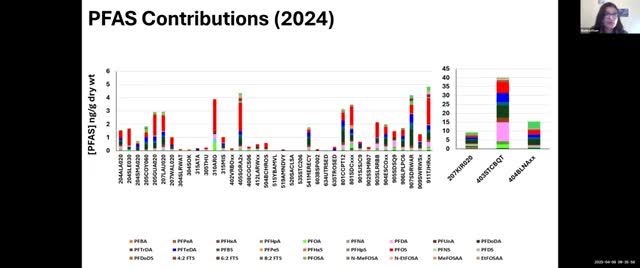Study reveals complex PFAS profiles across polluted sites in Region 4
April 26, 2025 | California Water Quality Monitoring Council, Boards and Commissions, Executive, California
This article was created by AI summarizing key points discussed. AI makes mistakes, so for full details and context, please refer to the video of the full meeting. Please report any errors so we can fix them. Report an error »

The California Water Quality Monitoring Council's recent meeting highlighted significant findings regarding PFAS (per- and polyfluoroalkyl substances) contamination across the state. In 2024, monitoring revealed PFAS at 35 sites, consistent with previous years, indicating ongoing concerns about these harmful chemicals.
The council discussed a suite of 40 PFAS compounds, including legacy substances like PFOS and PFOA, as well as newer alternatives marketed as safer. Notably, several urban sites exhibited complex mixtures of PFAS in sediments, with three sites showing the highest concentrations. These sites, particularly one in Bouquet Canyon, demonstrated increased PFAS levels in 2024 compared to 2023, raising alarms about the evolving nature of contamination.
While the top three sites with the highest detection rates remained unchanged, they are recognized as toxic due to other contaminants, not solely PFAS. The council emphasized the importance of tracking these complex PFAS profiles over the coming years to better understand their impact on public health and the environment.
In addition to PFAS discussions, the meeting briefly touched on other contaminants, with plans to revisit the topic of polycyclic aromatic hydrocarbons (PAHs) in future discussions. The council's ongoing monitoring efforts are crucial for addressing water quality issues and safeguarding community health in California.
The council discussed a suite of 40 PFAS compounds, including legacy substances like PFOS and PFOA, as well as newer alternatives marketed as safer. Notably, several urban sites exhibited complex mixtures of PFAS in sediments, with three sites showing the highest concentrations. These sites, particularly one in Bouquet Canyon, demonstrated increased PFAS levels in 2024 compared to 2023, raising alarms about the evolving nature of contamination.
While the top three sites with the highest detection rates remained unchanged, they are recognized as toxic due to other contaminants, not solely PFAS. The council emphasized the importance of tracking these complex PFAS profiles over the coming years to better understand their impact on public health and the environment.
In addition to PFAS discussions, the meeting briefly touched on other contaminants, with plans to revisit the topic of polycyclic aromatic hydrocarbons (PAHs) in future discussions. The council's ongoing monitoring efforts are crucial for addressing water quality issues and safeguarding community health in California.
View full meeting
This article is based on a recent meeting—watch the full video and explore the complete transcript for deeper insights into the discussion.
View full meeting
